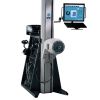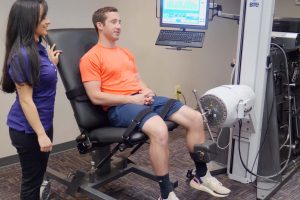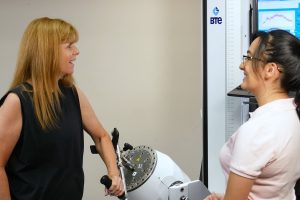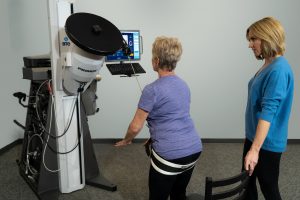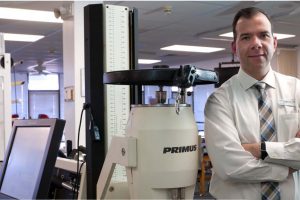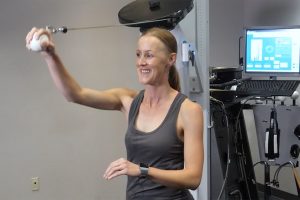
5 Exercises To Treat Shoulder and Scapular Pain With PrimusRS
BTE System GuidesWorking our way from isolated strengthening to fully integrated movement, we’ll show you five shoulder exercises on the PrimusRS.
Dealing with shoulder pain? Try these shoulder exercises on the PrimusRS cable system with your shoulder/scapular clients.
Working our way from isolated strengthening to fully integrated movement, we’ll show you these shoulder exercises:
- Protraction/retraction
- Internal rotation
- External rotation
- Standing shoulder extension with retraction and external rotation
- Full throwing simulation
These exercises can help your client regain shoulder/scapular strength and function.
In our last video, we showed you a creative twist on CPM exercises for the shoulder using Eccentrics and Target Force with the BTE PrimusRS. Today, we’re advancing to a more aggressive series. These shoulder exercises address injuries to the rotator cuff, labrum, or other soft tissue structures in the shoulder and scapula. These injuries can happen from falls at home, overuse at work, or sports related trauma.
Shoulder Exercises With the Cable System
The cable system gives you the ability to provide full functional movement. Whether you are isolating the area of concern, or moving on to incorporate the entire kinetic chain, PrimusRS provokes muscle activation with both concentric and eccentric contractions.
Scapular strength and stabilization are the foundation to healthy shoulder function. These shoulder exercises are a must in any shoulder strengthening program regardless of client population. By using isotonics with BTE, you support your client’s natural movement patterns, unlike other methodologies like isokinetics.
Shoulder Protraction / Retraction
First, we will focus on building scapular mobility and stability in isolation. We’ll start with a shoulder protraction / retraction. During retraction, we start by looking at the Primus with the arm forward flexed to 90 degrees. We then want to instruct our client to concentrically contract the rhomboids, creating a retraction motion. They will eccentrically resist the motion returning to the start position.
To isolate the serratus anterior with protraction, simply rotate your client so they are facing away from the Primus.
Depending on your client’s needs, you can use several different handles for this exercise. Most people find it easy to start with the wrist strap, then progress to more complex hand positions like the J handles or the spheres.
Shoulder Internal Rotation
Next is a shoulder internal rotation with the shoulder at 90 degrees abduction. This position is very common in sports, jobs, and even some ADLs, making this exercise invaluable for rehab.
For this shoulder exercise, the client is going to concentrically push down (or internally rotate) while the Primus provides resistance. This activates the shoulder internal rotators in isolation so that later, we can build up to a full throwing or multidimensional overhead movement simulation.
You can alternate between different handles, grip styles, and speeds to create specific sports or ADL activities. The wrist strap is a great way to add an extra challenge to this exercise.
Shoulder External Rotation
Now, we will do standing shoulder external rotation at 90 degrees abduction. This is an inherently weak motion for most people, and it’s very difficult to isolate using other methods. The PrimusRS gives you a precise, reliable way to measure and perform this movement.
This shoulder exercise is usually harder than internal rotation. So you’ll want to start with lower resistance and a more stable handle, like a small sphere. This exercise requires the client to eccentrically resist as the Primus pulls the arm back into internal rotation. Now we’re isolating the external rotators such as the teres minor and infraspinatus in both the concentric and eccentric phase.
We usually start out with the J handle, and when the client is ready, you can progress to the wrist strap, and the small or large spherical objects.
Shoulder Extension With Retraction and External Rotation
Progressing through the shoulder exercise series, next we will perform standing shoulder extension with retraction and external rotation. This one is a pretty challenging exercise. It addresses strength, stability, and mobility in the scapula and shoulder in one continuous movement pattern. Doing this exercise on the PrimusRS allows you to provide constant eccentric resistance through each point in motion.
With this exercise on the cable system, we’re creating a protraction of the scapula first. Then the client will retract until the shoulder is in a neutral position. From there, they’ll perform a shoulder extension until the elbow is at 90 degrees flexion. Lastly, they’ll begin the external rotation and they’ll be challenged to maintain the stable scapular position.
This is a dynamic and compound shoulder exercise, and it’s really beneficial for a wide variety of clients including industrial workers, paramedics, nurses, and athletes.
Controlled Throwing Simulation
Finally, we can do a simulated throwing motion with a sphere. This exercise is obviously great for athletes who need to train through the full throwing motion. But it is also very powerful for clients like firefighters, construction, healthcare workers and others doing multi-dimensional overhead movements.
The client will be engaging their entire upper body, their lower extremity and core, just like in a live sports throw. Once you’ve progressed from the isolated strengthening to this fully functional simulation, you can address any biomechanical improvements the client may need.
Conclusion
The shoulder is a complex yet commonly injured joint. With the BTE PrimusRS there are countless ways to address the isolation of each motion before safely progressing to these major integrated functions.
The five shoulder exercises we showed you today on the PrimusRS can help your client regain scapular and shoulder strength and function. You can add variety by using different attachments or working from seated and standing positions. Changing heights and angles opens up countless possibilities for creative simulation.
If you have a certain condition or tool you want to learn more about on the PrimusRS, let us know! Subscribe to TherapySpark for the latest rehab techniques.
Colleen Isaiah
TherapySpark Editor
BTE

